This reproduced page is from our first website. It is now listed for review and reconstruction to a new high standard, as with many such pages it holds inaccuracies created by an inappropriate cause to be disclosed.
Mission: Ramitelli, Southern Italy
Date: 31st July 1944 (Monday)
Unit: 436th Troop Carrier Group, 79th Troop Carrier Squadron
Type: C-47 Dakota
Serial: 43-15153
Code: S6 - ?
Base: Capodichino, Naples, Italy
Location: Irpinia, Southern Italy
Pilot: Lt. Howard B. Wank
Co-Pilot: Lt. Marvin (NMI) Butz
Crew Chief: Sgt. Raymond H. Kelley
Radio Operator: S/Sgt. Charles T. Taylor
Passengers:
904th Air Base Security Battalion, 366th Infantry Regiment (Bravo Company)
PFC. Walker Dozier. 34556823. U.S. Army. Killed
PFC. Morgan Fairfield Jr. 34056592. U.S. Army. Killed
T/Sgt. James A. Gaston. 33098086. U.S. Army. Killed
PFC. Theodore Harrison. 33097861. U.S. Army. Killed
Sgt. James Calvin Wyatt. 33181790. U.S. Army. Killed
Sgt. Earnest Hill. 33096953. U.S. Army. Killed
PFC. William L. Hill. 34144263. U.S. Army. Killed
PFC. Loney Portee. 33181358. U.S. Army. Killed
PFC. James A. Wright. 32070411. U.S. Army. Killed
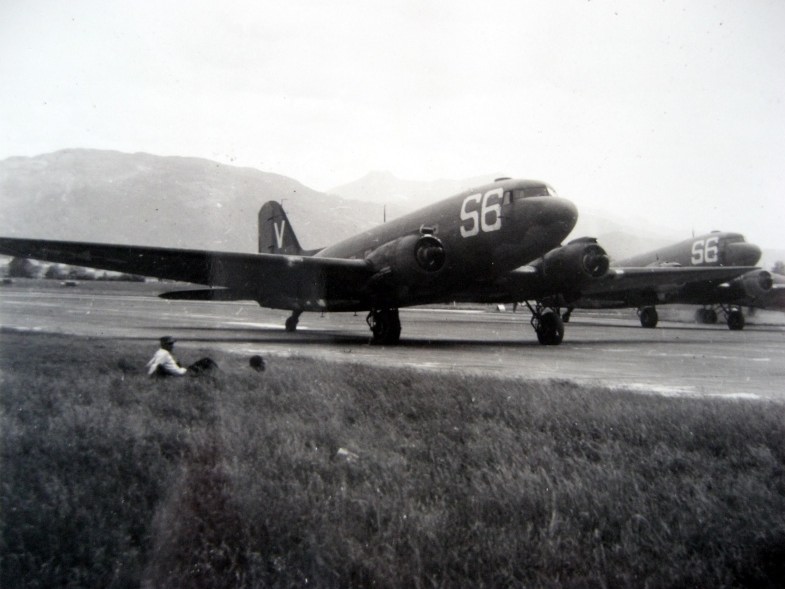
79th Troop Carrier Squadron C-47s Preparing to take-off.
REASON FOR LOSS:
Five aircraft took off at 8.00am from Capodichino airport to ferry coloured soldiers to Foggia with the final destination being, Ramitelli in Southern Italy.
These aircraft was flying under a heavy bank of fog when suddenly a mountain appeared ahead. Three aircraft managed to take evasive action, one plane touched the top of some trees causing structural damaged but the pilot managed to regain control and to reach his destination. The fourth aircraft hit some trees causing the Dakota to crash into the base of the mountain, killing nine of the eighteen coloured passengers
The four aircrew and a further thirteen people survived this crash
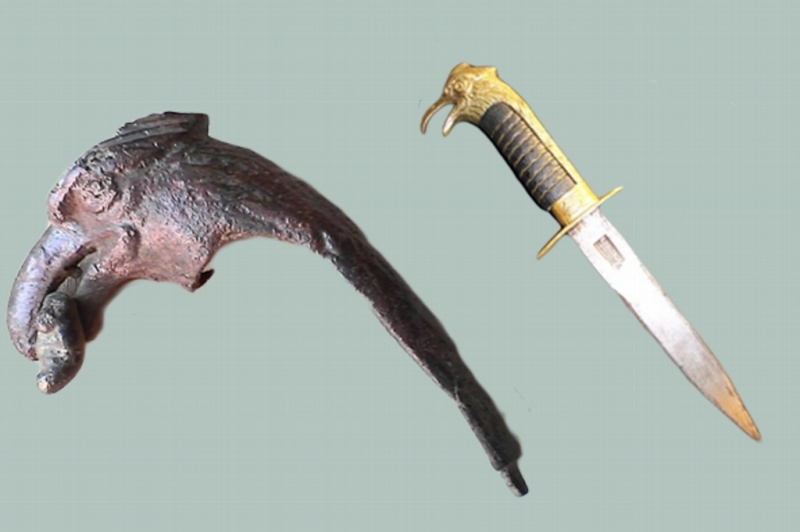
Eagle head from dagger with complete example for comparison.
Account of crash site investigation with photos of items recovered, by Matteo Pierro.
THE LOST PLATOON
The pieced together history of a plane crash in 1944 in Irpinia:
"On 31st July at 10 am a powerful twin-engine transport airplane was direct to the war front in Normandy, with 19 people on board and precious material (witnesses saw, among the wreckage, packages of banknotes burning), falling at the base of the mountains. The disaster was probably originated by the dense fog that forced the unit to fly too low " This limited information reported in an old book written in the year 1945, related to the war events that occurred in Irpinia (south Italy) gave me the input to start the discovery of this umpteenth crash site, with the collaboration of Salerno Air Finders, a group of dedicated researchers belonging to the Association Salerno1943. We had once again the precious and valuable support provided by Mario Dello Russo who collected the information from those who were aware of this event.
The details received seemed very accurate as they indicated a precise small area. Unfortunately, a first inspection revealed to be a false start except for a couple of pieces of aluminium that convinced us that we were on the right track.
Two other trips had the same result. On the way back from the third excursion, however, Daniele Gioiello, found a piece of aluminium that was certainly part of the plane because revealed the presence of rivets and the olive drab colour, typical of the American aircraft of World War II. The area of the finding was in a place totally different from what we were told. With the fourth excursion thus we explored this new side of the mountain and after the first few findings we came to an area where we finally found fragments of the plane. The high concentration of pieces makes us understand that we have finally found the point of impact!
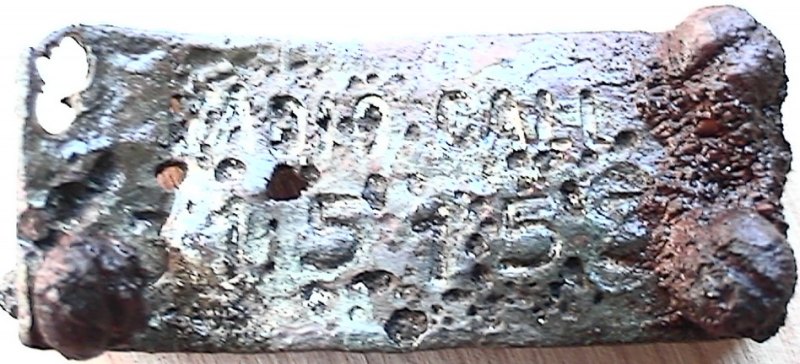
The plate with the serial number of aircraft RADIO CALL 315153, which clearly show traces left by the fire.
Many pieces are collected to be cleaned and examined in order to give a number and a name to the plane and its crew. The decisive information we received from two very small pieces. The first is a metal plate 3 cm long and 1 wide. On it you can barely read "RADIO CALL 315153". As explained by the friends of "Archeologi dellíaria", it is a label that was applied to the radio of the aircraft and served as a reminder to the radio operator, in calls, to quote the number of the aircraft's serial number that was 43 -15153.
Thus we learned that the plane in question was a C-47 Dakota, a versatile plane used for air transportation. This same aircraft, only a few weeks earlier, participated along with other aircraft of the 79th Troop Carrier Squadron to the launch of Airborne paratroopers of the 101^ (units made popular by the T.V show Band of Brothers produced by Spielberg and Hanks) on the happening of the landing in Normandy.
The crew consisted of:
Lt pilot. Howard B. Wank, the co-pilot. Marvin (NMI) Butz, the crew chief Sgt. Raymond H. Kelley and radio operator Sgt. Charles T. Taylor.
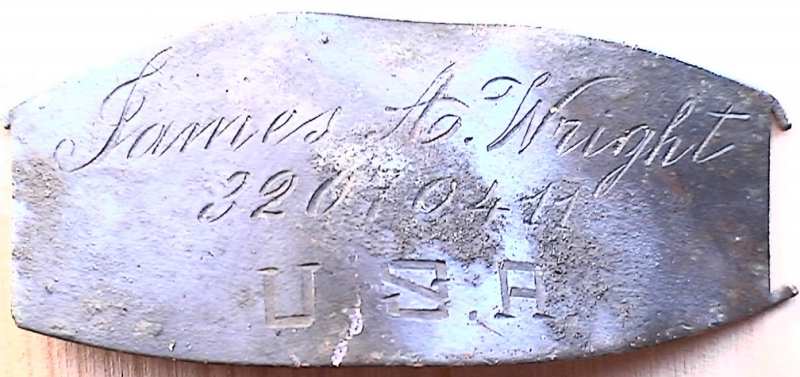
Remains of the I.D. bracelet of the soldier James A. Wright
But what were they doing in Campania and who were they carrying? The answer came from another small metal fragment. This time it was a piece of bracelet 2cm long and 4 cm wide. On it the unfortunate owner engraved his name and serial number: "James A. Wright 32070411 USA". With the help of Dave Berry who did a quick search in the archives of the U.S. military, it turns out that James A. Wright had died on July 31st 1944 and was buried in a common grave along with eight other fellow soldiers in the military cemetery at Jefferson Barracks in Missouri.
Thus it was possible to know the identity of the 9 victims of this disaster. They were:
Dozier Walker of Carroll County, GA
Fairfield Morgan Jr. of Palm Beach County, FL
Gaston, James A of Norfolk County, VA
Harrison, Theodore of Sussex County, VA
Wyatt James C of Brunswick County, VA
Hill, Earnest of Surrey County, VA
Hill, William L of Shelby County, TN
Portee, Loney of Washington, DC
Wright, James A of Atlantic County, NJ
These men were part of the 366th Infantry Regiment, a unit composed of black soldiers (also known as Buffalo Soldiers) whose job was to oversee security at Ramitelli airport used in Molise from 332 Squadron of Colonel Benjamin O. Davis Jr. In this airport the pilots were coloured and were known during the war as the Redtails. Their job was to escort U.S. bombers on daylight bombing missions. The movie Red Tails, directed by Anthony Hemingway and with Terrence Howard and Cuba Gooding Jr, which will be in theatres in January 2012, was based on this regiment.
They were chosen for this job because the regiments composed by white people refused to protect coloured pilots. Obviously in those years the racial feelings were still strong in the U.S. Army.

Numerous personal items, including lenses, coin and buttons
The destination indicated in the book, therefore, was incorrect. It was not a transfer to Normandy but instead to Foggia with Ramitelli being the final destination.
The formation of these C-47 had departed from Capodichino airport in that morning, July 31st 1944. A few minutes later came across a bank of fog that prevented the pilots to see the mountain towards which they were headed. Suddenly the steep wooded slope appeared in the eyes of pilots. Most of them managed to steer and regain altitude. One plane touched the tops of the trees causing structural damage but the pilot managed to bring it up and reach his destination safely. Lieutenant Wank, however, after hitting some trees in the valley with his aircraft collided against the base of the mountain.

More of a large number of buttons found
Evidently, the C-47 was overloaded and difficult to manoeuvre. In addition to the 18 men carried and the 4 crew people, the aircraft had full fuel tanks and the cockpit was filled with all the necessary equipment to troops. In fact, in the scene of the disaster were found fragments of camp cots, cartridges for light and heavy weapons, boxes of food rations, personal effects, etc. The impact did not have to be particularly violent because 13 men managed to escape death.
But who was imprisoned in the Dakota did not escape because of the violent fire which followed the fall. The large amount of fuel in the tanks turned the plane into a flashlight and ammunition began to explode in a short time the fire made havoc of everything.
The traces of the violence of the fire can be seen in the fragments of glass and metal deformed by the heat. To the rescuers remained very little to do but to gather the poor remains of the victims that the fire had rendered unrecognisable, thereby preventing the burials in individual graves.
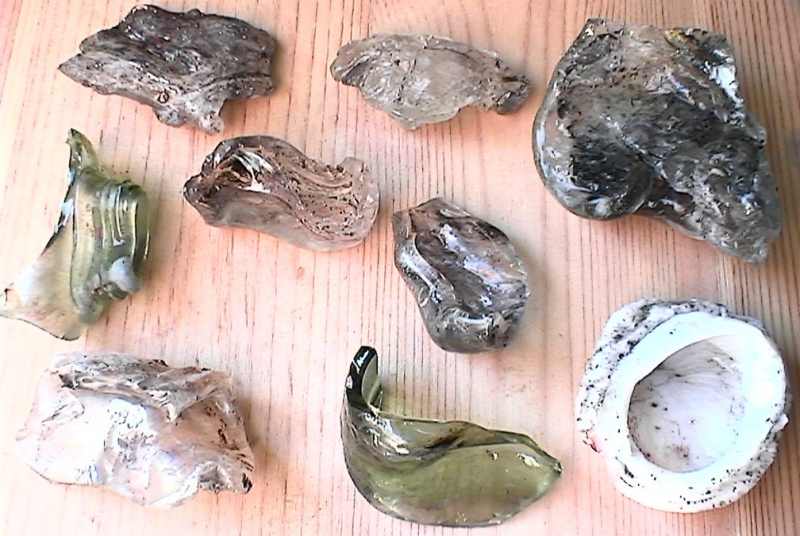
Fragments of glass containers deformed by fire.
In all these years the relatives of the victims had no way of knowing the circumstances of the death of their loved ones. In this regard, U.S. Army records are sketchy.
The grandson of James C. Wyatt believed that his uncle had fallen in Tuscany! The researchers hope to be able to return to the families of these poor soldiers some personal effects which were found. Like the handle of a knife made by Fratelli di Napoli Scuotto.
It depicts an eagle's head and had to serve as a prototype for the MVSN officers' sword. The sword was never put into production, but after the liberation of Naples, the handles were used to make daggers that were similar to those provided to graduates of the Militia, so that it could be sold to Allied soldiers seeking souvenirs of the campaign of Italy to take home.
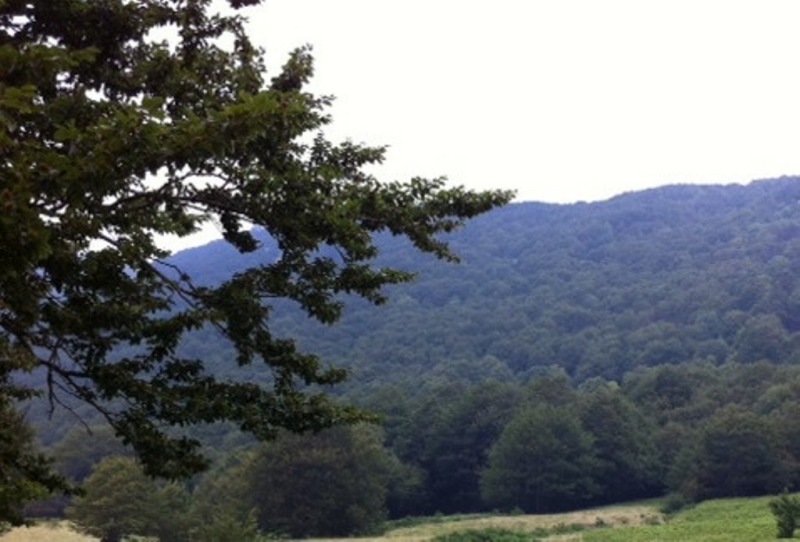
This wooded hillside was the point of impact.
Anyone who can provide informations to get in touch with the families of the victims can contact the society on our contact page, Any help will be greatly appreciated.
Following the disaster, the locals scavenged the wreckage so that they could sell pieces to smelters to help the meagre income available in those difficult years of war. Today the evidence of the disaster are virtually invisible to the untrained eye and only the perseverance and patience of the researchers made it possible to find traces of the tragedy.
To them, Gerardo Capuano, Francesco De Cesare, Mario Dello Russo, Vittorio De Maio, Luigi Fortunato, Daniele Gioiello, Gianluca Guerriero, Pierpaolo Irpino Martucciello Angelo, Matteo Ragone, Alessandro Russo and Gigino Vitolo, goes a big thank you for having shed light on this plane crash and its poor victims.
The Salerno Air Finders hope to shed light on many other air disasters they have heard of. Whoever wants to help, both with the recoveries and with informations can contact them via their Facebook page or by email to the Association Salerno 1943
Matteo Pierro
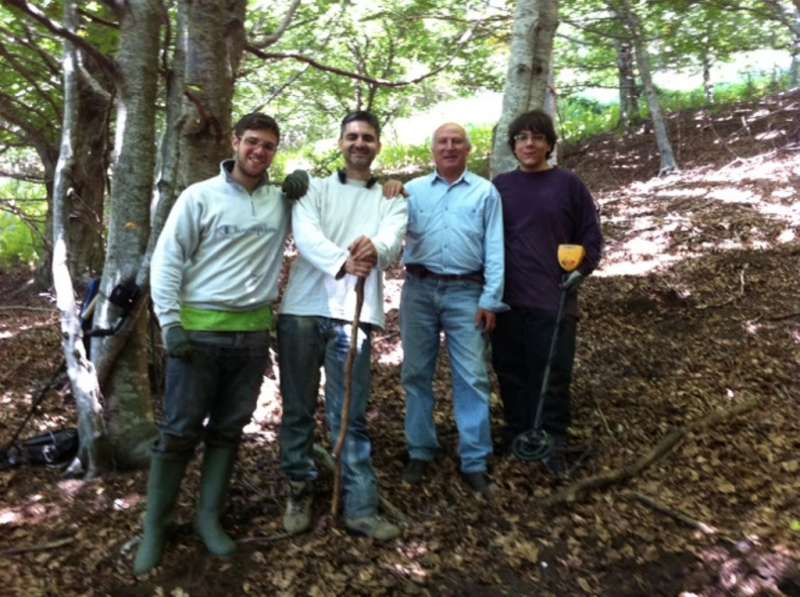
Some of the recovery and research team: Gianluca Guerriero, Pierpaolo Irpino, Mario Dello Russo and Angelo Martucciello.
Burial details:
The nine soldiers killed were first buried at the American Military Cemetery, Naples.
On the 17th January 1950 the nine men were buried in a joint grave at Jefferson Barracks National Cemetery, Saint Louis, Missouri. Section 79. Site 461-463

The memorial stone that commemorates the 9 victims in the cemetery at Jefferson Barracks in Missouri.
For further burial details:
Researched by: Matteo Pierro, David King and Kate Tame for the A.R. Society and the relatives of the crew
Acknowledgments: Matteo Pierro
Mission: Ramitelli, Southern Italy
Date: 31st July 1944 (Monday)
Unit: 436th Troop Carrier Group, 79th Troop Carrier Squadron
Type: C-47 Dakota
Serial: 43-15153
Code: S6 - ?
Base: Capodichino, Naples, Italy
Location: Irpinia, Southern Italy
Pilot: Lt. Howard B. Wank
Co-Pilot: Lt. Marvin (NMI) Butz
Crew Chief: Sgt. Raymond H. Kelley
Radio Operator: S/Sgt. Charles T. Taylor
Passengers:
904th Air Base Security Battalion, 366th Infantry Regiment (Bravo Company)
PFC. Walker Dozier. 34556823. U.S. Army. Killed
PFC. Morgan Fairfield Jr. 34056592. U.S. Army. Killed
T/Sgt. James A. Gaston. 33098086. U.S. Army. Killed
PFC. Theodore Harrison. 33097861. U.S. Army. Killed
Sgt. James Calvin Wyatt. 33181790. U.S. Army. Killed
Sgt. Earnest Hill. 33096953. U.S. Army. Killed
PFC. William L. Hill. 34144263. U.S. Army. Killed
PFC. Loney Portee. 33181358. U.S. Army. Killed
PFC. James A. Wright. 32070411. U.S. Army. Killed

79th Troop Carrier Squadron C-47s Preparing to take-off.
REASON FOR LOSS:
Five aircraft took off at 8.00am from Capodichino airport to ferry coloured soldiers to Foggia with the final destination being, Ramitelli in Southern Italy.
These aircraft was flying under a heavy bank of fog when suddenly a mountain appeared ahead. Three aircraft managed to take evasive action, one plane touched the top of some trees causing structural damaged but the pilot managed to regain control and to reach his destination. The fourth aircraft hit some trees causing the Dakota to crash into the base of the mountain, killing nine of the eighteen coloured passengers
The four aircrew and a further thirteen people survived this crash

Eagle head from dagger with complete example for comparison.
Account of crash site investigation with photos of items recovered, by Matteo Pierro.
THE LOST PLATOON
The pieced together history of a plane crash in 1944 in Irpinia:
"On 31st July at 10 am a powerful twin-engine transport airplane was direct to the war front in Normandy, with 19 people on board and precious material (witnesses saw, among the wreckage, packages of banknotes burning), falling at the base of the mountains. The disaster was probably originated by the dense fog that forced the unit to fly too low " This limited information reported in an old book written in the year 1945, related to the war events that occurred in Irpinia (south Italy) gave me the input to start the discovery of this umpteenth crash site, with the collaboration of Salerno Air Finders, a group of dedicated researchers belonging to the Association Salerno1943. We had once again the precious and valuable support provided by Mario Dello Russo who collected the information from those who were aware of this event.
The details received seemed very accurate as they indicated a precise small area. Unfortunately, a first inspection revealed to be a false start except for a couple of pieces of aluminium that convinced us that we were on the right track.
Two other trips had the same result. On the way back from the third excursion, however, Daniele Gioiello, found a piece of aluminium that was certainly part of the plane because revealed the presence of rivets and the olive drab colour, typical of the American aircraft of World War II. The area of the finding was in a place totally different from what we were told. With the fourth excursion thus we explored this new side of the mountain and after the first few findings we came to an area where we finally found fragments of the plane. The high concentration of pieces makes us understand that we have finally found the point of impact!

The plate with the serial number of aircraft RADIO CALL 315153, which clearly show traces left by the fire.
Many pieces are collected to be cleaned and examined in order to give a number and a name to the plane and its crew. The decisive information we received from two very small pieces. The first is a metal plate 3 cm long and 1 wide. On it you can barely read "RADIO CALL 315153". As explained by the friends of "Archeologi dellíaria", it is a label that was applied to the radio of the aircraft and served as a reminder to the radio operator, in calls, to quote the number of the aircraft's serial number that was 43 -15153.
Thus we learned that the plane in question was a C-47 Dakota, a versatile plane used for air transportation. This same aircraft, only a few weeks earlier, participated along with other aircraft of the 79th Troop Carrier Squadron to the launch of Airborne paratroopers of the 101^ (units made popular by the T.V show Band of Brothers produced by Spielberg and Hanks) on the happening of the landing in Normandy.
The crew consisted of:
Lt pilot. Howard B. Wank, the co-pilot. Marvin (NMI) Butz, the crew chief Sgt. Raymond H. Kelley and radio operator Sgt. Charles T. Taylor.

Remains of the I.D. bracelet of the soldier James A. Wright
But what were they doing in Campania and who were they carrying? The answer came from another small metal fragment. This time it was a piece of bracelet 2cm long and 4 cm wide. On it the unfortunate owner engraved his name and serial number: "James A. Wright 32070411 USA". With the help of Dave Berry who did a quick search in the archives of the U.S. military, it turns out that James A. Wright had died on July 31st 1944 and was buried in a common grave along with eight other fellow soldiers in the military cemetery at Jefferson Barracks in Missouri.
Thus it was possible to know the identity of the 9 victims of this disaster. They were:
Dozier Walker of Carroll County, GA
Fairfield Morgan Jr. of Palm Beach County, FL
Gaston, James A of Norfolk County, VA
Harrison, Theodore of Sussex County, VA
Wyatt James C of Brunswick County, VA
Hill, Earnest of Surrey County, VA
Hill, William L of Shelby County, TN
Portee, Loney of Washington, DC
Wright, James A of Atlantic County, NJ
These men were part of the 366th Infantry Regiment, a unit composed of black soldiers (also known as Buffalo Soldiers) whose job was to oversee security at Ramitelli airport used in Molise from 332 Squadron of Colonel Benjamin O. Davis Jr. In this airport the pilots were coloured and were known during the war as the Redtails. Their job was to escort U.S. bombers on daylight bombing missions. The movie Red Tails, directed by Anthony Hemingway and with Terrence Howard and Cuba Gooding Jr, which will be in theatres in January 2012, was based on this regiment.
They were chosen for this job because the regiments composed by white people refused to protect coloured pilots. Obviously in those years the racial feelings were still strong in the U.S. Army.

Numerous personal items, including lenses, coin and buttons
The destination indicated in the book, therefore, was incorrect. It was not a transfer to Normandy but instead to Foggia with Ramitelli being the final destination.
The formation of these C-47 had departed from Capodichino airport in that morning, July 31st 1944. A few minutes later came across a bank of fog that prevented the pilots to see the mountain towards which they were headed. Suddenly the steep wooded slope appeared in the eyes of pilots. Most of them managed to steer and regain altitude. One plane touched the tops of the trees causing structural damage but the pilot managed to bring it up and reach his destination safely. Lieutenant Wank, however, after hitting some trees in the valley with his aircraft collided against the base of the mountain.

More of a large number of buttons found
Evidently, the C-47 was overloaded and difficult to manoeuvre. In addition to the 18 men carried and the 4 crew people, the aircraft had full fuel tanks and the cockpit was filled with all the necessary equipment to troops. In fact, in the scene of the disaster were found fragments of camp cots, cartridges for light and heavy weapons, boxes of food rations, personal effects, etc. The impact did not have to be particularly violent because 13 men managed to escape death.
But who was imprisoned in the Dakota did not escape because of the violent fire which followed the fall. The large amount of fuel in the tanks turned the plane into a flashlight and ammunition began to explode in a short time the fire made havoc of everything.
The traces of the violence of the fire can be seen in the fragments of glass and metal deformed by the heat. To the rescuers remained very little to do but to gather the poor remains of the victims that the fire had rendered unrecognisable, thereby preventing the burials in individual graves.

Fragments of glass containers deformed by fire.
In all these years the relatives of the victims had no way of knowing the circumstances of the death of their loved ones. In this regard, U.S. Army records are sketchy.
The grandson of James C. Wyatt believed that his uncle had fallen in Tuscany! The researchers hope to be able to return to the families of these poor soldiers some personal effects which were found. Like the handle of a knife made by Fratelli di Napoli Scuotto.
It depicts an eagle's head and had to serve as a prototype for the MVSN officers' sword. The sword was never put into production, but after the liberation of Naples, the handles were used to make daggers that were similar to those provided to graduates of the Militia, so that it could be sold to Allied soldiers seeking souvenirs of the campaign of Italy to take home.

This wooded hillside was the point of impact.
Anyone who can provide informations to get in touch with the families of the victims can contact the society on our contact page, Any help will be greatly appreciated.
Following the disaster, the locals scavenged the wreckage so that they could sell pieces to smelters to help the meagre income available in those difficult years of war. Today the evidence of the disaster are virtually invisible to the untrained eye and only the perseverance and patience of the researchers made it possible to find traces of the tragedy.
To them, Gerardo Capuano, Francesco De Cesare, Mario Dello Russo, Vittorio De Maio, Luigi Fortunato, Daniele Gioiello, Gianluca Guerriero, Pierpaolo Irpino Martucciello Angelo, Matteo Ragone, Alessandro Russo and Gigino Vitolo, goes a big thank you for having shed light on this plane crash and its poor victims.
The Salerno Air Finders hope to shed light on many other air disasters they have heard of. Whoever wants to help, both with the recoveries and with informations can contact them via their Facebook page or by email to the Association Salerno 1943
Matteo Pierro

Some of the recovery and research team: Gianluca Guerriero, Pierpaolo Irpino, Mario Dello Russo and Angelo Martucciello.
Burial details:
The nine soldiers killed were first buried at the American Military Cemetery, Naples.
On the 17th January 1950 the nine men were buried in a joint grave at Jefferson Barracks National Cemetery, Saint Louis, Missouri. Section 79. Site 461-463

The memorial stone that commemorates the 9 victims in the cemetery at Jefferson Barracks in Missouri.
For further burial details:
Researched by: Matteo Pierro, David King and Kate Tame for the A.R. Society and the relatives of the crew
Acknowledgments: Matteo Pierro
